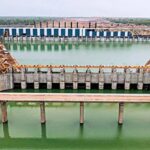Andhra Pradesh upcoming capital city, ‘Amaravati‘, true it modern vision, will focus on encouraging renewable energy sources such as solar, biomass, and waste in the Capital City to make it India’s first uninterrupted power supply (UPS) city.
The strategy for power supply is laid out in the Master Plan released last week. The master plan is prepared keeping in view the growth in demand of the capital which is planned as the world-class city. The government expects no power shortage for the city in the immediate future. As the city evolves into a world-class city, the demand for power is expected to put enormous pressure on the power supply. The vision of the architects of the master plan is to have uninterrupted power supply to Amaravati as it is being planned as one among top five cities in the world. This can be achieved by connecting the City to national grid and by adopting non-conventional generation to augment the supply from Vijayawada Thermal Power station (VTPP)
To begin with power needs of the new capital will be met by the Vijayawada Thermal Power Plant , which is located just outside the northern boundary of the capital city on the northern bank of the Krishna River. Development of renewable energy sources can be considered to supplement the conventional power supply to the Capital City,” the master plan stated.
“By implementing modern grid technologies such as bidirectional meters, the capital city may also sell excess energy produced from the renewable energy sources such as solar panels back to the grid as an additional source of supply, therefore reducing supply demand from the national power grid,” the master plan suggested.
VTPP is Amaravati’s nearest power plant.There is an allocation of 1,000 MW and another 800 MW is planned from the upgrading of the VTPP to supply to the Capital City. For the realization of entire master plan there should be guaranteed supply from the VTPP. This , however, is still not sufficient to meet the long-term demands of the Capital City. There is a need for the detailed development strategy in place to ensure that the Capital City power demands are met fully.
According to the master plan, the Capital City area is well located to connect it to the national power grid of India. There are currently several transmission lines running through the development area. The power lines currently link the Vijayawada Thermal Power Plant to a primary electrical substation which distributes power to the existing towns and villages within the Capital City area and the south of the Capital City, including Thullur.
“VTPP is a regional power plant and it supplies power to areas within and outside the Capital City. Although it has spare capacity currently and has set aside about 1,000 MW for the development of the new Capital City, the government should ensure that the spare capacity is not eroded by other demand outside of the Capital City,” the master plan suggested.
“AP government should also put in place concrete steps to demonstrate how it can supply the 1,000 MW to the Capital City. This is crucial to ensure the viability of the Capital City. Even with the 1,000 MW reserved for the Capital City, there is still a need to source for additional supply to meet the ultimate demand of the Capital City of 3766 MW with newer and more modern technologies,” the blueprint advised.
It further stated that there must be a study further to conduct a detailed feasibility study on the need to upgrade the VTTP and the need to construct a new power plant to meet the ultimate power demand of the Capital City.

































